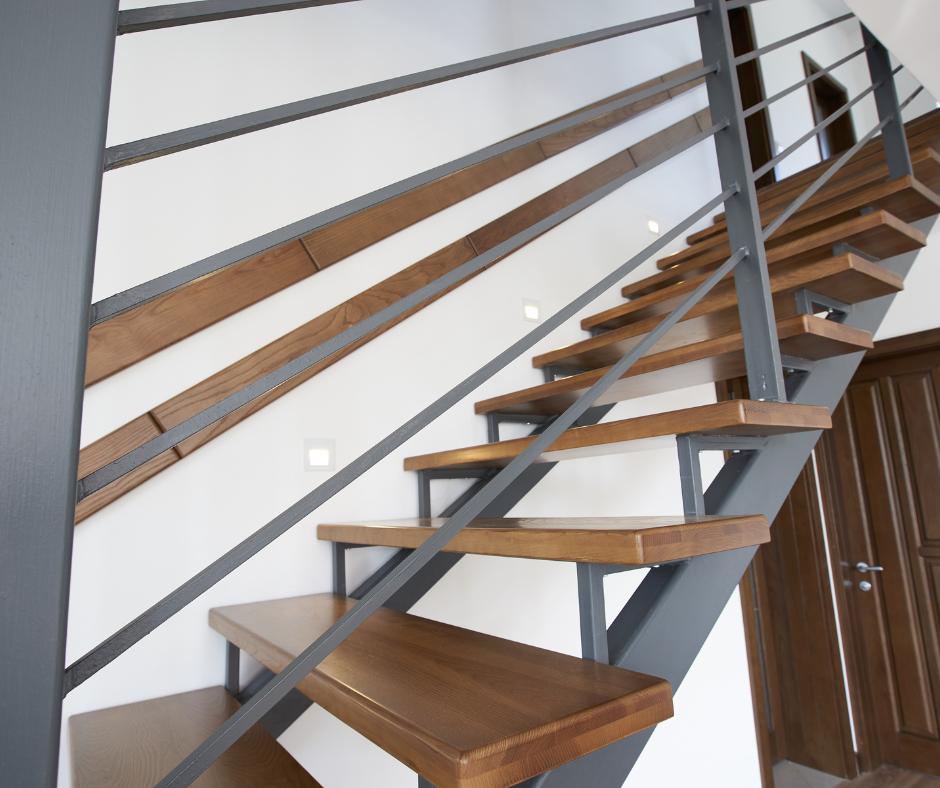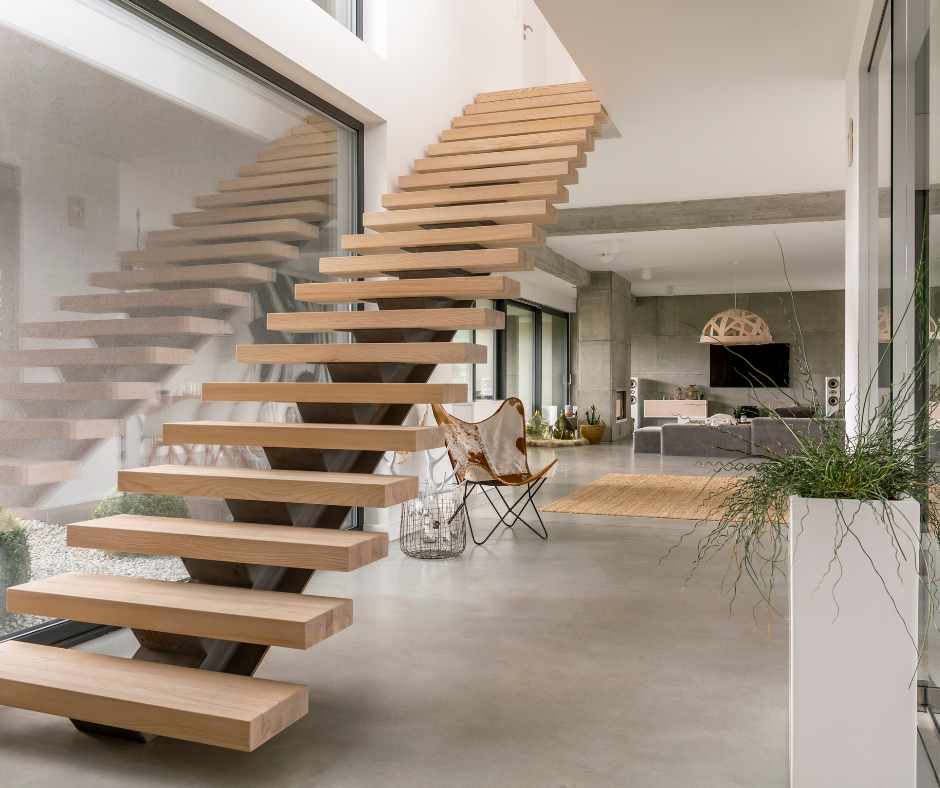Looking to upgrade your home with a bold, stylish touch?
Modern style floating wood stairs are a sleek, open staircase design that appears to “float” without visible supports.
They’re often paired with carpet stair treads to boost comfort and safety without compromising aesthetics.
In this guide, you’ll learn exactly how floating stairs are built, why they’re safe, and how to personalize them for your home.
We’ll cover key benefits, maintenance tips, and design ideas that add both beauty and function.
Whether you're remodeling or starting from scratch, this walkthrough will help you choose smart, stylish options.
How Floating Wood Stairs Work
At first glance, these staircases look like magic—treads that seem to hover in midair.
But behind the scenes is smart engineering and strong craftsmanship.
Each step is anchored to a hidden support system, typically a steel spine or a wall-mounted bracket.
That invisible structure gives you the look of floating steps while still meeting safety standards and bearing weight with ease.
This setup not only creates a cleaner look but allows more light and space to flow freely through the stairwell.
In many homes, this type of design becomes a focal point.
It's not just a way to get upstairs—it's a style statement.
Materials That Make a Difference
When it comes to building modern style floating wood stairs, the materials you choose matter.
Most homeowners lean toward solid woods that offer both strength and visual warmth.
Popular choices include:
-
White Oak – A timeless, light-colored wood that complements a range of interior styles
-
Walnut – Rich and dark, this wood brings depth and contrast
-
Maple – Durable and smooth, with a clean, pale finish
-
Hickory – Strong and unique, great for rustic or transitional homes
Wood treads can be left natural, stained, or sealed with protective finishes to match your décor.
Many homeowners also mix materials—pairing wood with glass railings or metal accents for a custom, upscale look.
Why Homeowners Are Choosing Floating Wood Stairs
Floating stairs aren’t just for modern architecture magazines.
More homeowners are choosing this style because of the benefits it brings to real, everyday living.
Light and Open Feel
The most immediate benefit is space.
Traditional staircases can make entryways or hallways feel boxed in.
But floating stairs open up the area visually and physically, allowing light to pass through and giving the illusion of more room.
Long-Lasting Style
These staircases don’t just look good now—they’ll look good for decades.
Their clean lines, minimal shapes, and high-quality materials mean they won’t go out of style anytime soon.
DIY Appeal with Custom Results
With professional guidance, many parts of the process—like choosing stair landings, finishes, or layouts—can be DIY-friendly.
You don’t need an interior designer to create a high-end feel in your home.
You just need the right solution and support.
Adding Comfort and Safety with Carpet Stair Landings
One of the best ways to customize modern style floating wood stairs is by adding carpet stair landings.
These landing zones—placed at turns or pauses in your staircase—offer a soft, secure surface to step on.
And they’re more than just practical.
Why Carpet Landings Matter
-
Safety – Reduces the risk of slips, especially for children or pets
-
Comfort – Softens your steps and cushions your footfall
-
Design Integration – Adds texture and color that enhances your overall interior
Whether you go for a neutral tone that matches your wood or a bold pop of color that adds personality, carpet landings help you bring the look together.
What Is a Self Supporting Staircase?
If you’ve been exploring floating stairs, you’ve probably come across the term and asked yourself, what is a self supporting staircase?
A self-supporting staircase is a type of stair design where each tread is strong enough to hold weight without relying on traditional framework.
Instead of using large beams or visible risers, self-supporting stairs often use hidden steel cores, wall-mounting brackets, or central spines for stability.
This innovative design is what makes the “floating” effect possible.
You don’t need an entire support wall underneath the staircase.
The treads literally hold themselves up, thanks to precise engineering and high-quality materials.
Because they are self-contained and structurally sound, these staircases are also ideal for open layouts.
They’re visually lighter, safer than they look, and extremely versatile in design.
How Safe Are They?
It’s a question we hear all the time—and it’s a good one.
Because floating stairs don’t look like traditional staircases, people wonder if they’re stable enough for families with kids or pets.
The answer is yes.
Floating stairs, especially self-supporting models, are built to meet building codes and weight limits.
When designed and installed correctly, they are just as safe as any other staircase.
If you’re still concerned, here are some tips to make them even safer:
-
Use non-slip coatings or treads
-
Add railings on both sides for better balance
-
Include carpet stair landings for added grip
-
Choose wider steps to make each stride more secure
These additions don’t take away from the beauty of floating stairs—they add to it.
Floating Wood Stair Design Ideas to Inspire Your Space
Ready to dream up your own custom staircase?
Here are some floating wood stair design ideas to consider for your next project.
Mix Wood and Glass
One of the most popular floating wood stair design ideas is to pair wood treads with glass railings.
This gives your staircase a clean, uninterrupted line while still maintaining safety.
The glass lets light flow freely, making your entire home feel brighter.
Go Dark for Drama
Try a rich walnut or dark-stained oak for a staircase that feels bold and grounded.
In contrast with lighter walls, this creates a dramatic focal point that’s modern and inviting.
Add Lighting
Install LED strip lighting underneath each tread to emphasize the floating effect.
This not only adds style but also improves visibility—especially in the evenings.
Choose Custom Carpet Landings
Blend function with fashion by choosing stair landings that match your home’s décor.
Whether you love subtle textures or statement-making patterns, your landings can be as unique as your home.
Use Metal Accents
For an industrial-modern blend, choose stair brackets or railings in matte black or brushed steel.
This combo adds depth and contrast to lighter wood tones and fits well in minimalist spaces.
These ideas are just the beginning.
Because each staircase is custom-built, you can tailor every detail to suit your taste and home layout.
Maintaining Your Floating Wood Stairs
Floating stairs are surprisingly easy to maintain if you start with good materials and follow a few simple steps.
Regular Cleaning
Dust the treads regularly with a microfiber cloth to keep surfaces clean and reduce buildup.
For deeper cleaning, use a wood-safe product and avoid excess moisture.
Protect the Finish
Apply protective sealants or wood oil every 6–12 months, depending on usage.
This keeps your stairs looking polished and helps prevent wear over time.
Check for Stability
Although the structure is hidden, it's good practice to have a professional check the supports periodically.
A quick inspection every year can catch small issues before they become problems.
With just a little upkeep, your staircase will keep looking beautiful for years to come.
Stepping It Up
Modern style floating wood stairs bring together everything today’s homeowner is looking for—sleek design, open space, and family-friendly features.
Whether you're remodeling your entryway or building a new home, this type of staircase offers the perfect balance of form and function.
Adding features like carpet stair landings and LED lighting lets you tailor the design to your family’s needs while preserving the clean, open look that makes floating stairs so appealing.
At Oak Valley Designs, we believe everyone deserves a space they feel proud of.
That’s why we offer expert support, customizable options, and easy-to-install stair solutions that bring your vision to life.
Let’s create something beautiful together.
-
Website: https://oakvalleydesigns.com/
-
Phone: 706.331.0315
-
Email: info@oakvalleydesigns.com
-
Address: 30 River Ct SW Bldg E Cartersville, Ga 30120




